Rating of the best sound cards for the studio for 2025
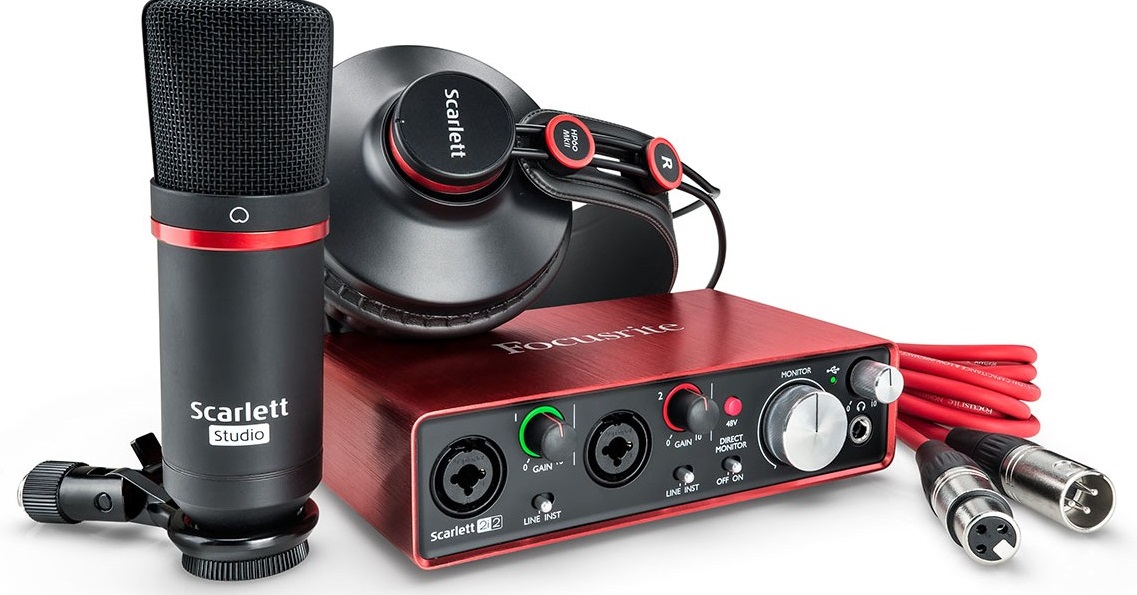
In the music world, sound processing in the studio is widespread. This makes it possible not only to achieve purity of sound, but also to remove all extraneous noise. All musical equipment is coordinated by one center - an audio interface, which brings the work of all components into a single system (microphone, speakers, monitors, etc.). The quality of the final track directly depends on how successful the map will be.
In this article, we will tell you how to choose a sound card, what to look for in order not to make mistakes, and also compile a rating of high-quality audio interfaces based on customer reviews.
Content [Hide]
Criteria for choosing a sound card
- Connection method.
Depending on the selected type, the information transfer rate and device throughput may vary. For a home studio, the type of connection does not really matter, but for a professional one, it is worth understanding the features of each of them.
Three different types are on sale: USB, Thunderbolt and FireWire. According to some musicians, the latter option transmits sound better and is faster than USB. However, there are also opposite opinions. FireWire was originally designed to transmit audio to Macintosh computers, its main purpose was to transmit multimedia with maximum performance. Thunderbolt assumes a universal purpose - it is able to transfer any data between computer devices, and has a good speed. USB was also developed as a universal port, designed to unify data connectors in personal computers, its main differences were simplicity and low cost. Initially, FireWire was the flagship among these three groups, the standard to strive for. This interface works on a principle different from those used in the other two - it connects two equal devices together, and does not use any adapters. The other two interfaces require the use of a hub that allows media transfer.In other words, without the use of a control center (for example, a laptop), information cannot be exchanged. However, it should be noted that today any computer equipment is equipped with a USB connector, and in most of them there are 2 or more. The other two interfaces are used less often, and only on devices of the highest price category. It is worth noting that any of the above options is suitable for working with multimedia files - watching videos, listening to music and processing audio.
- Number of inputs and outputs.
The higher this parameter, the more versatile the audio interface. The buyer is offered a choice of a large number of combinations. Since the functionality of electronics directly depends on this parameter, it is recommended to immediately decide how many and what kind of musical instruments will be connected to the studio. In case of an error, you will have to adjust the number of channels, which is not always possible with inexpensive models. Connectors come in the following varieties: digital, optical, coaxial, etc. Since you will need to connect monitors to the audio interface, the type of connectors matters. The presence of a MIDI connector allows you to use a synthesizer, professional keyboard and other necessary devices.
- Availability of additional connectors.
This parameter characterizes the ability to change the purpose of the studio, and apply those tools that have not been used before. As in the previous criterion, it is worth focusing on equipment that has as many inputs and outputs as possible.
- Sampling frequency and bit depth.
This parameter is one of the most important. It characterizes the output code for the analog-to-digital converter, as well as the input code for the reverse process.Experienced musicians recommend choosing a bit depth of 32 bits or more, and a sampling rate of 50 kHz or more.
- DSP effects.
Some high-end cards are equipped with a DSP processor. Such a device allows you to reduce the load on the PC processor and process sound effects until the moment of recording. The presence of such effects is welcomed by many users, since they sound much better than the standard ones.
- Software.
Before buying, it is recommended to evaluate compatibility with the operating system used on your personal computer, and also check whether the driver is created specifically for this device, or if a universal one is used, compatibility with which sometimes leaves much to be desired.
- Phantom power available.
It is required only in one case - if you plan to use condenser-type microphones. If there is no such connector, you will have to purchase a special amplifier with phantom power function.
Recommendations for choosing a sound card
- For a small studio, there is no need to buy a device with expensive connectors, such as Thunderbolt or FireWire, it is enough to focus on the presence of a bus on a computer or laptop. In extreme cases, USB will do.
- The number of ports depends on what you plan to use the studio for - for example, only two items are enough for a guitar, and for drums you will have to choose models with 5 or more.
- When evaluating models, it is also recommended to compare the signal-to-noise ratio, the higher it is, the better. Values in the range of 75 - 114 dB are considered optimal.
- Even for a home studio, it is not recommended to use a built-in card, as it is significantly inferior to a professional one in many respects. First of all, it can handle only one media source, does not guarantee high quality sound, transmits extraneous noise, and unnecessarily loads the processor.
Rating of the best cards for a recording studio
Budget (price category up to 20,000 rubles)
Lexicon Alpha
votes 4
![]()
The review begins with one of the most budget cards. It is also the most compact in the Lexicon range. Country of manufacture - China. The popularity of this manufacturer's audio interface models is due to the low price threshold, as well as a good price-quality ratio. According to buyers, this card will be an excellent choice for a home recording studio. The gadget has not only a microphone, but also an instrumental input, so you can record two tracks at once.
The external device has a standard appearance - on the front panel there are controls for the instrumental and musical inputs, with an overload indicator, which makes it possible to adjust the sound volume. To record high-quality tracks, it is recommended not to use universal controls, but to connect a mixer with an equalizer. Also on the panel are mono / stereo switches, and volume control. There is a headphone jack (it is advisable to use it if it is not possible to isolate the room from extraneous noise).
All other connectors are on the rear panel. Their number and ratio is able to satisfy all the needs of a home studio.A USB interface is used to connect to a PC, so there is no need to look for additional adapters. You can connect a mixing and dynamic microphone to the audio interface. There is no phantom power. The package includes an instruction manual, a driver, and all necessary cables. The average price of a product is 5,500 rubles.
Specifications:
| Index | Meaning |
|---|---|
| Type of | external |
| Connection type | USB 1.1 |
| The need for additional power | No |
| Bit depth DAC/ADC | 24 bit / 24 bit |
| Maximum DAC frequency (stereo) | 48 kHz |
| Maximum ADC frequency | 48 kHz |
| DAC/ADC dynamic range | 100 dB / 96 dB |
| Analog outputs | |
| Channels, pcs. | 2 |
| Connectors, pcs. | 4 |
| Independent headphone outputs, pcs. | 1 |
| Analog inputs | |
| jack 6.3 mm | 3 |
| XLR | 1 |
| Microphone | 1 |
| Instrumental | 1 |
| Supported standards | |
| EAX | No |
| ASIO | v. 1.0 |
- compact overall dimensions;
- good price / quality ratio;
- good recording options.
- suitable only for a home studio, for a professional one you will have to look for something with more functionality.
Focusrite Scarlett Solo
votes 6
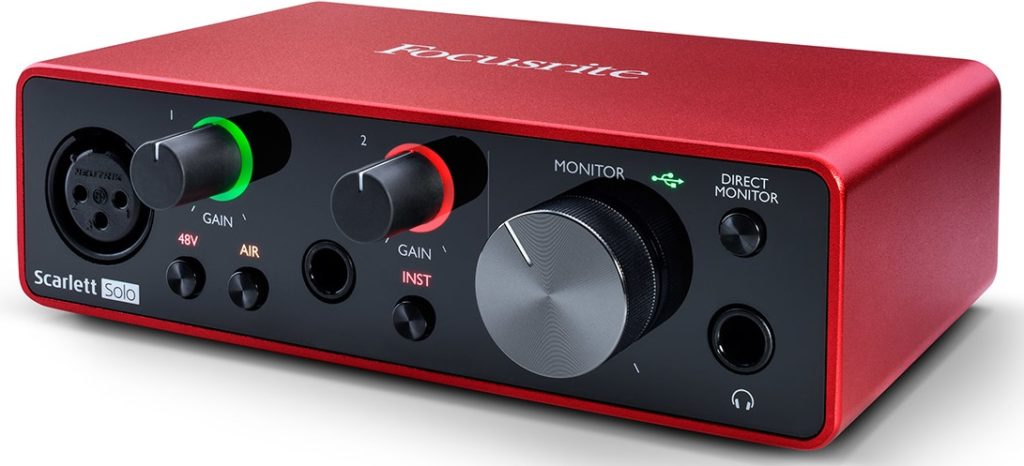
Another representative of the Celestial Empire continues the review, which costs a little more than the previous model, however, it also has a large set of characteristics. According to the manufacturer, in the third modification, the shortcomings of the first models were taken into account - clipping was eliminated, the delay was reduced, and sampling was also increased.
Users note high-quality materials of manufacture - for example, the body is made of aluminum. On the front panel there is an input for a microphone and for instruments, regulators, a 48 V socket, volume control.Users note the smooth operation of the controls, as well as convenient volume indicators. Among the advantages of the card, one can also single out the presence of the Plug and Play function (there are reviews that it may not work correctly on Windows, but this problem does not exist on Mac).
The device compares favorably with its bright color on store shelves compared to models from other manufacturers. Since the device is external, for better adhesion to the surface, it has two rubber strips on the case that prevent slipping during vibration. The average price of a product is 7,900 rubles.
Specifications:
| Index | Meaning |
|---|---|
| Type of | external |
| Connection type | USB |
| The need for additional power | No |
| Bit depth DAC/ADC | 24 bit / 24 bit |
| Maximum DAC frequency (stereo) | 192 kHz |
| Maximum ADC frequency | 192 kHz |
| phantom power | there is |
| Analog outputs | |
| Channels, pcs. | 2 |
| Connectors, pcs. | 2 |
| Independent headphone outputs, pcs. | 1 |
| Analog inputs | |
| jack 6.3 mm | 1 |
| XLR | 1 |
| Microphone | 1 |
| Instrumental | 1 |
| Supported standards | |
| EAX | No |
| ASIO | v. 2.0 |
- attractive appearance;
- the device is inexpensive;
- can be used for professional studio;
- buyers do not have problems with where to buy goods - they can be ordered online in any online store.
- little functionality.
Zoom UAC-2
votes 2
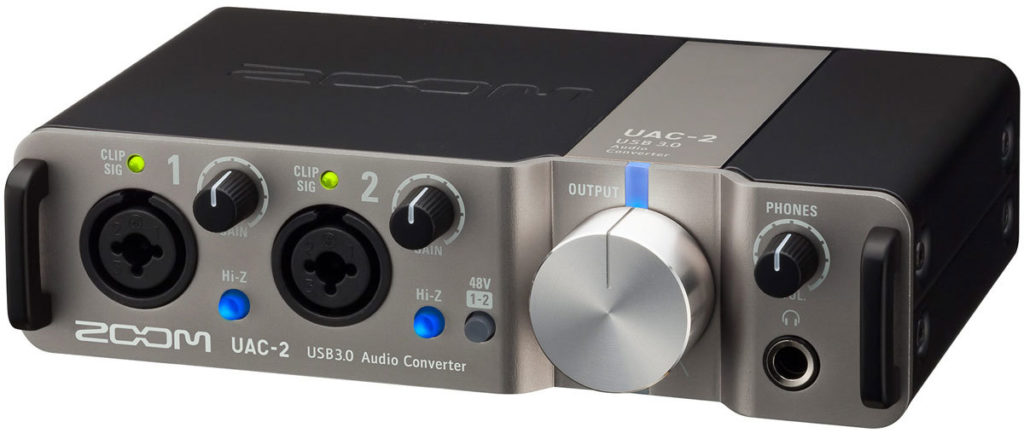
Since the product is made in Japan, its high quality is assumed by default. The product is produced in a metal case. Buyers note the unusual design of the device - on the front panel there are “twists” in a chaotic manner, as well as buttons with bright neon illumination. There is also a headphone jack and two sockets.
The main advantage of the device is the presence of a USB 3.0 interface, which transfers data an order of magnitude faster than its predecessors. The power cord will allow you not to use additional adapters when working with a personal computer, and for a tablet you will have to purchase them separately. The package includes an instruction manual, a driver disk (by the way, you can also download it on the official website of the manufacturer), as well as a cable for connecting to a PC. Users note that the device can be used to record almost any music, with the exception of a symphony orchestra.
Specifications:
| Index | Meaning |
|---|---|
| Type of | external |
| Connection type | USB 3.0 |
| The need for additional power | No |
| Bit depth DAC/ADC | 24 bit / 24 bit |
| Maximum DAC frequency (stereo) | 192 kHz |
| Maximum ADC frequency | 192 kHz |
| DAC/ADC dynamic range | 120 dB / 118 dB |
| Analog outputs | |
| Channels, pcs. | 2 |
| Connectors, pcs. | 2 |
| Independent headphone outputs, pcs. | 1 |
| Analog inputs | |
| jack 6.3 mm | 2 |
| XLR | 2 |
| Microphone | 2 |
| Instrumental | 1 |
| phantom power | there is |
| Supported standards | |
| EAX | No |
| ASIO | No |
- attractive appearance;
- one of the best budget offers for beginners;
- fast data transfer.
- In terms of functionality, it is inferior to the best manufacturers of sound cards.
Average price category (from 20,000 to 55,000 rubles)
PreSonus Studio 68c
votes 1

The novelty of the Chinese manufacturer is designed for use in small studios. Compared to its predecessors, the model has a more powerful amplifier applied to the headphone jack, with the latest generation of preamps.On the front panel of the device there are adjustment knobs, sound level indicators, control buttons, sockets for 48 V.
The disk that comes with the gadget contains plugins and a program for processing music. Users note fast data transfer (via USB 2.0 port). Due to the fact that the device is designed using modern preamps, the final sound is detailed and of high quality. The average price of a product is 28,000 rubles.
Specifications:
| Index | Meaning |
|---|---|
| Type of | external |
| Connection type | USB 1.1 |
| The need for additional power | there is |
| Bit depth DAC/ADC | 24 bit / 24 bit |
| Maximum DAC frequency (stereo) | 192 kHz |
| Maximum ADC frequency | 192 kHz |
| DAC/ADC dynamic range | 114 dB / 114 dB |
| Analog outputs | |
| Channels, pcs. | 4 |
| Independent headphone outputs, pcs. | 1 |
| Analog inputs | |
| jack 6.3 mm | 4 |
| XLR | 4 |
| Microphone | 4 |
| Instrumental | 1 |
| phantom power | there is |
| Supported standards | |
| EAX | No |
| ASIO | v. 2.0 |
| Other interfaces | |
| S/PDIF | coaxial |
| MIDI interfaces | 1.00 |
| firewire | 1 |
- a large number of settings;
- compatible with any operating system;
- the presence of the A / B button, which is responsible for the sound from which channel will be fed into the headphones;
- bright and informative screen;
- convenient regulators;
- a large number of connectors.
- external power is required.
Apogee Duet
votes 0
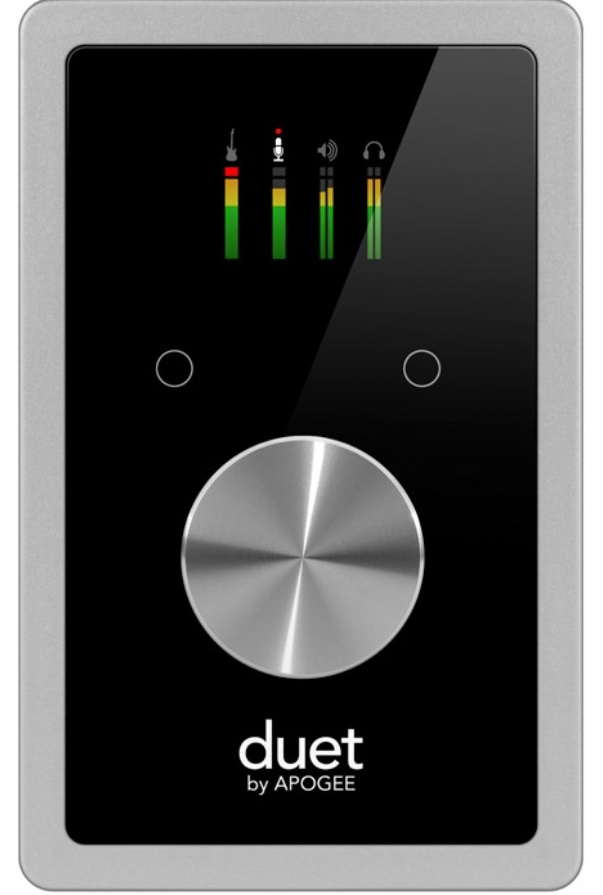
The brand is American, known to musicians and in many ways is a benchmark for other manufacturers. Despite the fact that the year of release of the device is considered to be 2007, the card has undergone a series of modifications and improvements since then.With the change in filling, the name of the product has not changed, and it is now sold in the store under the same name as in the year of the premiere. During the period of changing the technical parameters, the following changes took place: Firewire was replaced with USB, the processor was updated, thanks to which the device became compatible with Apple gadgets, it became possible to connect a keyboard and mixing console, and much more.
The body of the device is made of metal, resistant to scratches and other mechanical damage. Even the regulator located on the front panel is made of metal. When used without additional musical equipment (headphones, microphone), the gadget can be powered by a personal computer, otherwise it needs to be connected to the mains.
The device has a non-standard appearance, and immediately stands out from the competition. The bright display without superfluous elements reminds firm design of Apple. OLED technology allows you to view the image from any viewing angle. Of the design features of the gadget, you can select the connectors that are placed in the so-called "pigtail". In addition, there is an independent headphone output. The average price of a product is 52,000 rubles.
Specifications:
| Index | Meaning |
|---|---|
| Type of | external |
| Connection type | USB 2.0 |
| The need for additional power | there is |
| Bit depth DAC/ADC | 24 bit / 24 bit |
| Maximum DAC frequency (stereo) | 192 kHz |
| Maximum ADC frequency | 192 kHz |
| DAC/ADC dynamic range | 123 dB / 114 dB |
| Analog outputs | |
| Channels, pcs. | 4 |
| Connectors, pcs. | 3 |
| Independent headphone outputs, pcs. | 1 |
| Analog inputs | |
| jack 6.3 mm | 2 |
| XLR | 2 |
| Microphone | 2 |
| Instrumental | 1 |
| phantom power | there is |
| Supported standards | |
| EAX | No |
| ASIO | v. 2.0 |
- custom design, attractive appearance;
- popular model, can be found in stock in any specialized store;
- compatible with Apple gadgets, which is rare in audio interfaces;
- compact dimensions.
- users complain about how much the device costs - with limited functionality, it is in the price segment of advanced gadgets.
Universal Audio Apollo Twin MKII DUO
votes 1
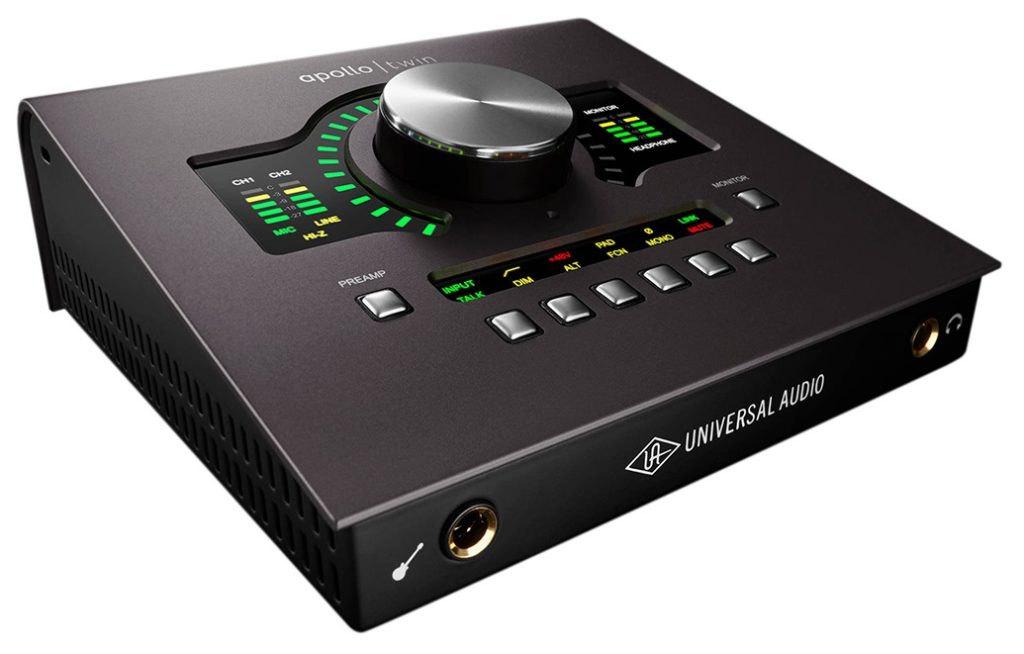
This gadget belongs to the category of professional, and has a corresponding cost. It uses the Thunderbolt bus, which allows you to achieve better sound than USB. Audio interfaces of the Apollo line are the best-selling among the brand's products.
The device can work with both Mac and Windows systems. Among the features of the model, we can single out the presence of a controller that processes music without additional load on the processor of the control computer. Users note the presence of a built-in microphone, which greatly simplifies the work with the device (direct connection). Buyers are offered a choice of three modifications: Solo, Duo and Quad, which differ from each other in the number of built-in processors, but are otherwise identical. The model under consideration has two chips.
The manufacturer claims that the musical equipment of its manufacture can be assembled in various ways, thus setting up the studio for individual needs. Users note the attractive appearance of the device, the intuitive layout of buttons and controls. The package includes a set of plug-ins (only available in demo mode), drivers, and cables.
Specifications:
| Index | Meaning |
|---|---|
| Type of | external |
| Connection type | Thunderbolt |
| The need for additional power | there is |
| Bit depth DAC/ADC | 24 bit / 24 bit |
| Maximum DAC frequency (stereo) | 192 kHz |
| Maximum ADC frequency | 192 kHz |
| Analog outputs | |
| Connectors, pcs. | 4 |
| Independent headphone outputs, pcs. | 1 |
| Analog inputs | |
| jack 6.3 mm | 3 |
| XLR | 2 |
| Microphone | 2 |
| Instrumental | 1 |
| phantom power | there is |
| Supported standards | |
| EAX | No |
| ASIO | v. 2.0 |
| S/PDIF | optic |
- suitable for a personal computer in a professional studio;
- is in the TOP of the best sound cards;
- the processor does not consume computer memory;
- there is phantom power;
- equipment can be modified, assembled and updated as technology improves.
- off-budget cost.
Premium (over 55,000 rubles)
MOTU UltraLite-mk3
votes 0
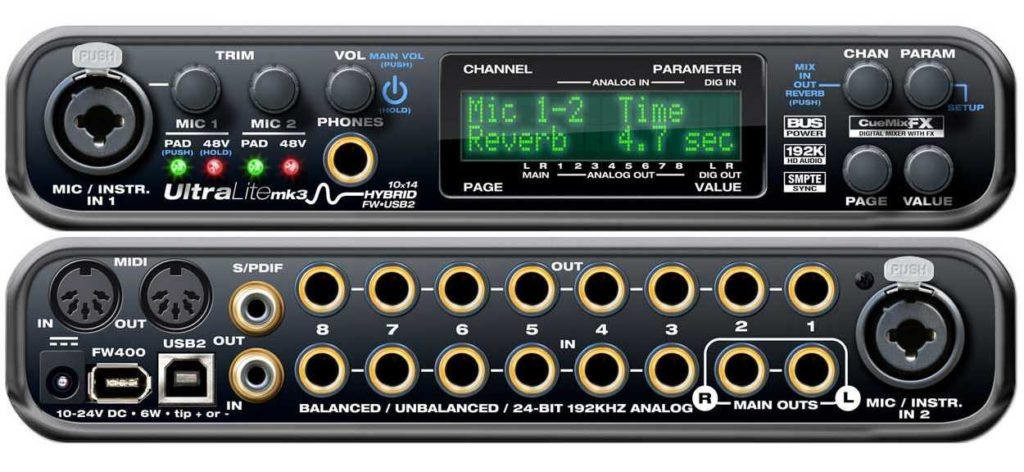
Another American representative has wide functionality, as well as a pleasant appearance. A feature of this gadget is the presence of a FireWire interface, which is rare in such electronics.
The gadget has a compact size, a large number of inputs and outputs (most of which are concentrated on the reverse side), ergonomic controls and a clear interface. Users note a durable case, thanks to which the device can be used not only in the studio, but also taken with them to concerts. The presence of a built-in processor allows you not to load the computer when processing music. There is also an equalizer that allows you to achieve optimal sound settings.
Users note the presence of two compressors - a built-in traditional one, as well as a Leveler, which is known to professional musicians.Of the convenient “chips”, you can also highlight the saving of mixer settings in the gadget’s memory, which can later be modulated when working with another computer. The package includes a technical description of the device, a driver for working with Windows or Mac, and a set of cables. The average price of a product is 56,000 rubles.
Specifications:
| Index | Meaning |
|---|---|
| Type of | external |
| Connection type | firewire |
| The need for additional power | there is |
| Multi-channel audio output capability | there is |
| Bit depth DAC/ADC | 24 bit / 24 bit |
| Maximum DAC frequency (stereo) | 192 kHz |
| Maximum ADC frequency | 192 kHz |
| Analog outputs | |
| Channels, pcs. | 8 |
| Connectors, pcs. | 8 |
| Independent headphone outputs, pcs. | 1 |
| Analog inputs | |
| jack 6.3 mm | 8 |
| XLR | 2 |
| Microphone | 2 |
| phantom power | there is |
| Supported standards | |
| EAX | No |
| ASIO | v. 2.0 |
| S/PDIF | optic |
| External sync support | there is |
| MIDI interfaces | 1/1 |
| FireWire ports, pcs. | 2 |
- USB and FW interfaces;
- slight delay;
- one of the best cards for the money;
- many settings can be configured without using a computer.
- some buyers complain that the device does not have USB power.
RME Fireface UCX
votes 0
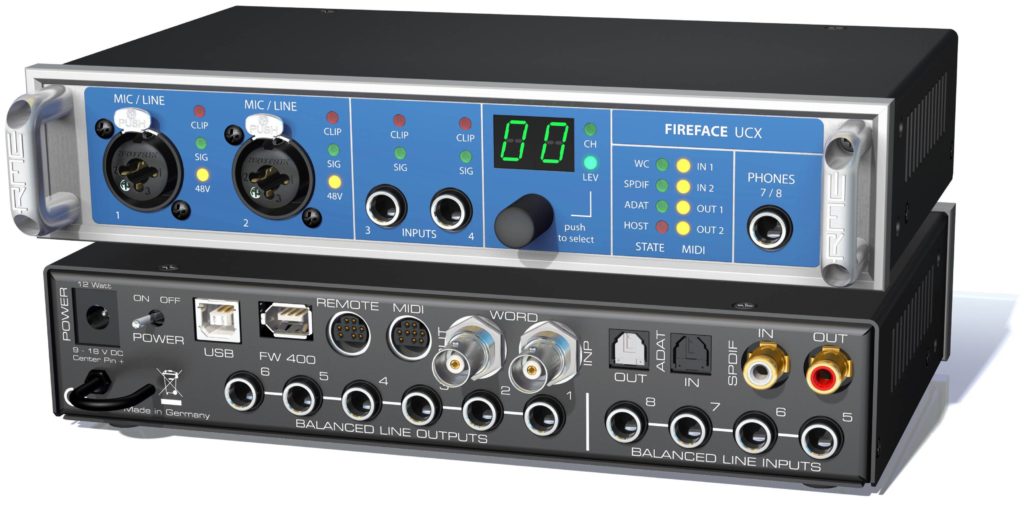
The product of the German manufacturer is known all over the world not only because of its wide functionality, but also due to its reliable, stable and durable operation. It is designed for frequent use and heavy workloads, and has performed well not only in professional studios, but also in high-level music concerts. Despite the compact size, the manufacturer managed to fit more than 300 electronic microelements into the case, which is a kind of record among such equipment.
Despite not the most attractive appearance, this audio interface has a high-quality stuffing, and high performance of music processing. So, users note a low latency, the presence of two microphone amplifiers, an integrated processor that independently copes with the load, as well as a large number of inputs / outputs (36 channels in total). The mixer is capable of handling all 36 sockets simultaneously. There is also a three-band equalizer, and a large number of customizable effects.
Specifications:
| Index | Meaning |
|---|---|
| Type of | external |
| Connection type | USB, FireWire |
| The need for additional power | there is |
| Multi-channel audio output capability | there is |
| Bit depth DAC/ADC | 24 bit / 24 bit |
| Maximum DAC frequency (stereo) | 192 kHz |
| Maximum ADC frequency | 192 kHz |
| Analog outputs | |
| Channels, pcs. | 8 |
| Connectors, pcs. | 7 |
| Independent headphone outputs, pcs. | 1 |
| Analog inputs | |
| jack 6.3 mm | 8 |
| XLR | 2 |
| Instrumental | 1 |
| Microphone | 2 |
| phantom power | there is |
| Supported standards | |
| EAX | No |
| ASIO | v. 2.0 |
| S/PDIF | coaxial |
| External sync support | there is |
| AES/EBU | there is |
| ADAT | there is |
| MIDI interfaces | 1/1 |
- stability of the card and drivers;
- wide functionality;
- a large number of positive user reviews;
- on the forums you can find a lot of tips on setting up the device and troubleshooting problems.
- there are complaints that the "twist" on the front panel is inconvenient;
- high price;
- it will be difficult for a novice musician to understand all the settings of the device.
RME Babyface PRO
votes 0
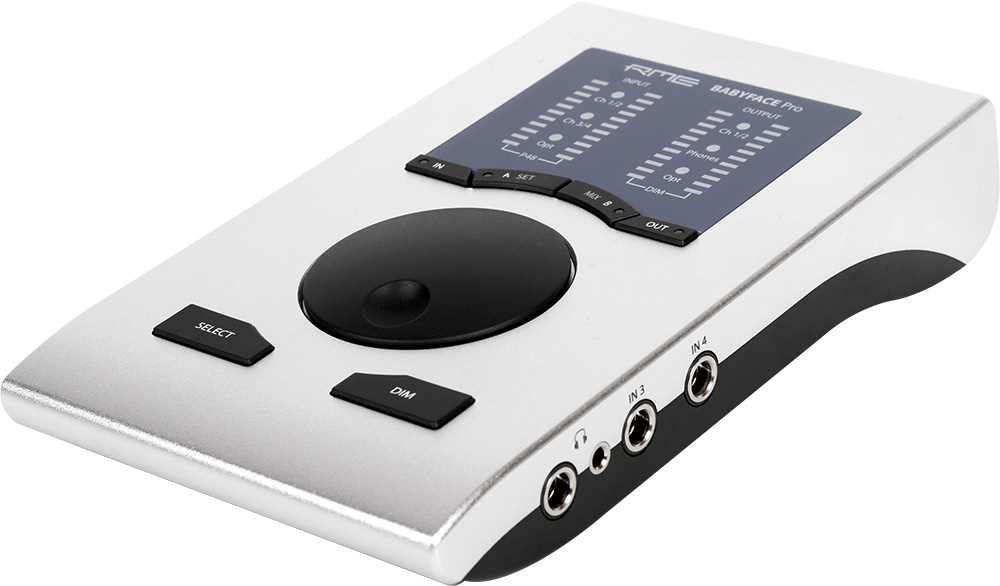
This gadget is produced by the same company as the previous contender, but it is cheaper in price and different in functionality.Products of this brand differ from competitors not only in price, but also in the principle of operation - the device is based on an FPGA matrix, the operation of which is fully customizable by the user, and not programmed at the factory. It has a minimum delay, as well as a universal audio routing system. Due to the fact that the development of such a matrix is expensive, not every musician can afford to purchase the final product.
Among the features of the model are the possibility of autonomous operation, convenient settings and a clear interface. Despite the fact that for the first time the predecessor of the model was released in 2011, today only a few competitors can compare with it in terms of functionality. After a certain amount of time, the device was redesigned, a modification was released with the Pro index, which is similar to the original device only in name, the filling was completely changed and finalized.
The product is sold in an all-metal aluminum case, which is not subject to mechanical damage and fits in a small bag, so you can take it with you anywhere. Along with the gadget, a plastic case is sold for it, in which you can also place cables and other components (for example, a power supply). The average price of a product is 65,000 rubles.
Specifications:
| Index | Meaning |
|---|---|
| Type of | external |
| Connection type | USB |
| Bit depth DAC/ADC | 24 bit / 24 bit |
| Maximum DAC frequency (stereo) | 192 kHz |
| Analog outputs | |
| Channels, pcs. | 4 |
| Independent headphone outputs, pcs. | 2 |
| Analog inputs | |
| XLR | 2 |
| Instrumental | 1 |
| Microphone | 2 |
| Supported standards | |
| EAX | No |
| ASIO | v. 2.0 |
| S/PDIF | optic |
| ADAT | there is |
| MIDI interfaces | 1/1 |
- compact dimensions;
- durable aluminum body;
- mobility;
- high detail throughout the entire sound range;
- built-in microphone amplifier.
- Mac requires additional driver downloads;
- high price;
- some users complain about the difficulty of working with Total Mix.
Conclusion
Many novice musicians, when choosing a sound card, have a hard time imagining what it is and what it is for. When deciding which company's products to buy, you should not focus only on the data of Internet resources, evaluating the device according to the description and photo. We recommend that you learn the basics of sound recording on thematic forums, chat with musicians, and also consult with a consultant in a store who will tell you which model you should pay attention to.
If you are just starting to work with sound and do not plan to make large investments, you can consider buying a second-hand sound card. As a rule, most of them are sold in good technical condition and, if they are products of a well-known brand, do not bring any problems to the new owner.
We hope that our article will help you understand all the variety of audio interfaces and make the right choice!
new entries
Categories
Useful
Popular Articles
-

Top ranking of the best and cheapest scooters up to 50cc in 2025
Views: 131666 -

Rating of the best soundproofing materials for an apartment in 2025
Views: 127703 -

Rating of cheap analogues of expensive medicines for flu and colds for 2025
Views: 124529 -

The best men's sneakers in 2025
Views: 124048 -

The Best Complex Vitamins in 2025
Views: 121952 -

Top ranking of the best smartwatches 2025 - price-quality ratio
Views: 114988 -

The best paint for gray hair - top rating 2025
Views: 113405 -

Ranking of the best wood paints for interior work in 2025
Views: 110332 -

Rating of the best spinning reels in 2025
Views: 105339 -

Ranking of the best sex dolls for men for 2025
Views: 104378 -

Ranking of the best action cameras from China in 2025
Views: 102227 -

The most effective calcium preparations for adults and children in 2025
Views: 102020









